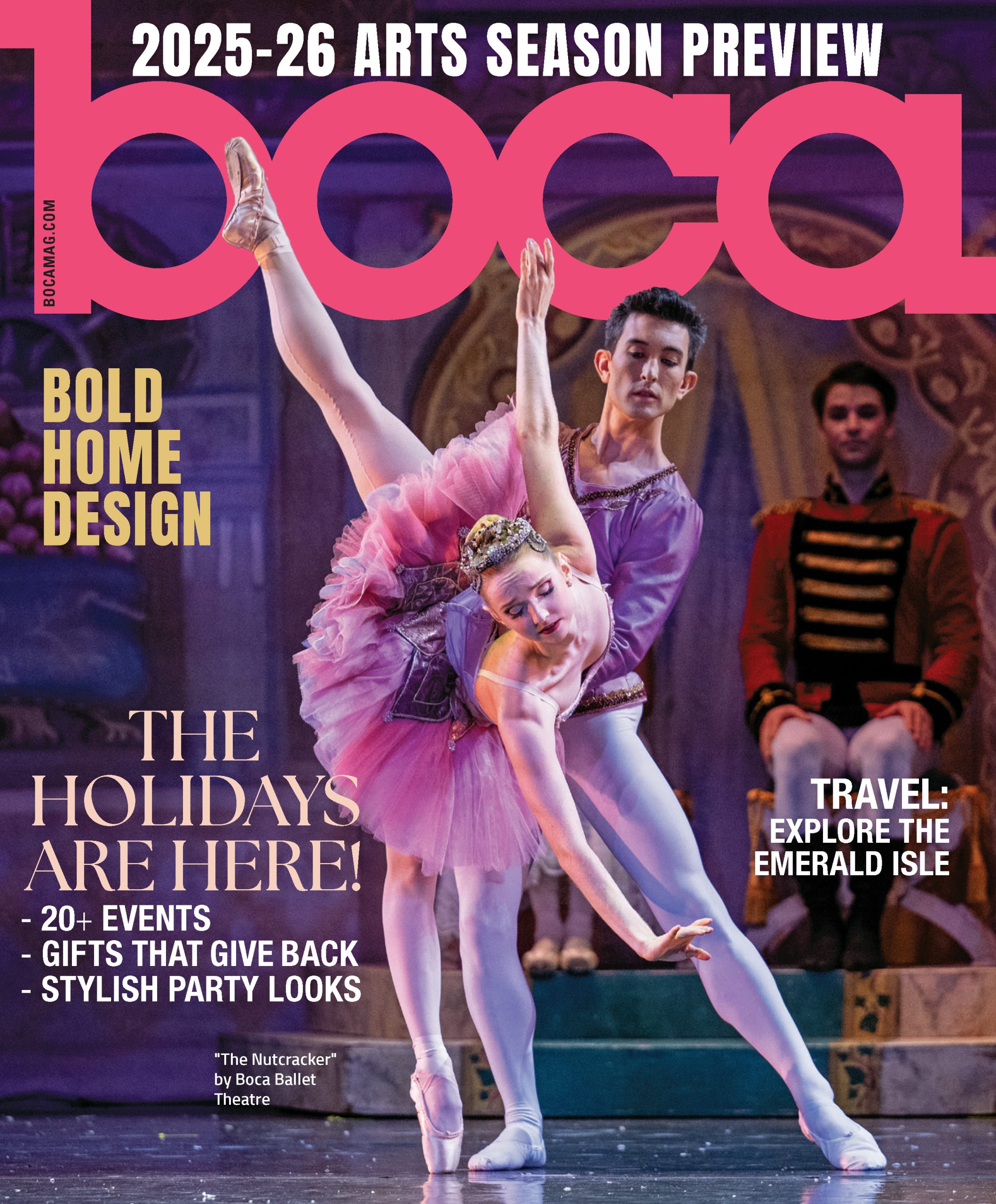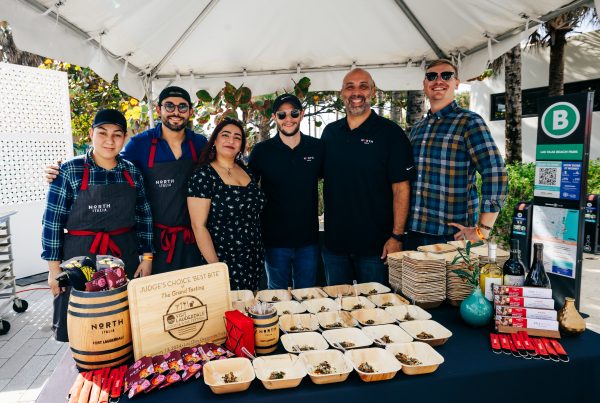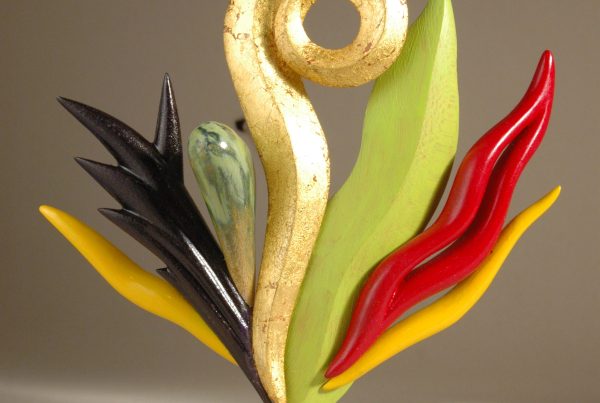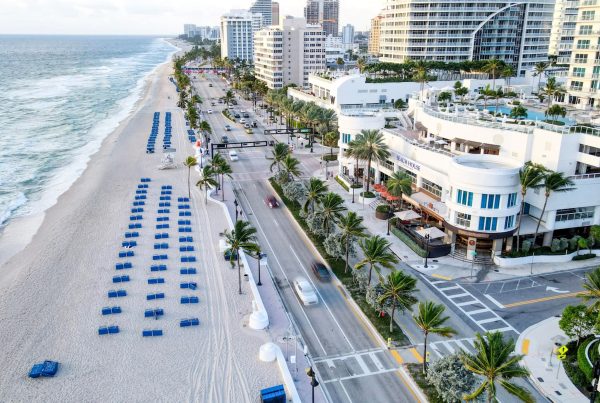The NSU Art Museum has rolled out the red carpet for its new show, but not in the traditional sense.
Far from being a footbath for the aristocracy, Mona Hatoum’s installation “Red Carpet” is inspired by an alleged 16th century sighting of the Virgin Mary in a Mexico City convent. Situated prominently at the entrance of the museum’s new exhibition, “Red Carpet” unspools from its carrier like an endless tongue, culminating in a likeness of the Holy Mother designed into the fabric.
Hatoum’s striking installation repurposes the very concept of the red carpet, shifting its meaning from the vain, modern-day idols of celebrity culture to an actual idol—and makes tactile the dubious claims of the faithful who have seen deities in toast and bed sheets. Here, the sacred image is so real we could, theoretically, step on it.
Hatoum, a contemporary multimedia artist famous for her beguiling, unnerving installations, deserves an entire floor, and maybe one day she’ll receive one in a South Florida museum. For now, this piece is all we get, but at least it’s in great company. She’s one of dozens of artists past and present, and from around the globe, chosen for “Remember to React,” a monumental retrospective celebrating the museum’s 60th anniversary.
Pulled entirely from the museum’s permanent collection, the works chosen for “Remember to React” underline its depth and breadth, its prizing of both abstract and figurative art, and its championing of the obscure and emerging artist alongside the established master. Furthermore, its reputation for diversity and multiculturalism in art is on full display, linking words of historical and contemporary import through ideas of intersectionality. If there’s a degree of self-congratulation in the proudly written wall text, it feels wholly earned: The museum was, and is, ahead of the cultural curve.
You just need to examine the works surrounding “Red Carpet,” in the show’s airiest and most impressive space, to capture these links across time, space, gender and genre. There’s South African artist Serge Nitegeka’s sprawling, mixed-media “Wall Drawing XIII,” which consumes an entire wall of the museum, and cleanly divides painted portions with unfinished wood as a reflection on global apartheid. Cuban artist Jose Bedia’s “A Violin for the Guardian Angel” is another work of stirring majesty and political symbolism involving one of the artist’s trademark hulking silhouettes, chain link fencing, cinder blocks and a model warplane. And Germany’s Jonathan Meese’s maximalist painting “SCARLETTIERBABY de METABOLISMEESEEWOLF” (pictured below) tackles his country’s fascist history through recurring images of phalluses, vortices and much more.

And those are just the leadoff hitters. Inside the galleries proper, we’re treated to an always-welcome roomful of Purvis Young’s raw, impassioned inventions, whose frames are as important to his legacy as their content. The museum has chosen symbolically loaded works painted on doors, window frames, carpet swatches and Disney dry-erase boards—revelations from an artist who upcycled before that was even a thing.

From Picasso’s “Madura” series
A selection of Pablo Picasso’s extraordinary animal-themed ceramics, with their characteristic whimsy, restraint and functionality, remind us how infrequently his work is shown in Florida museums. They wisely share real estate with representatives of the COBRA movement—the acronymic group formed in 1948 by artists from Cophenhagen, Brussels and Amsterdam. The NSU Art Museum is a major worldwide collector of COBRA art, with its deceptively childlike imagery and bold embrace of big, loud color. Visitors to the museum’s previous COBRA shows will encounter familiar pieces here, but the context allows us to view them anew, with Picasso’s cubism serving as an influence, either directly or indirectly.
“Remember to React” continues with an impressive selection from the museum’s giant collection of sub-Saharan African art, circa 1950. Often completed by unidentified artists, these wooden totems, animal sculptures and masks resonate as both spiritual and decorative exclamations, functioning as ritualistic disguises and monuments for posterity. I wasn’t terribly moved or inspired by it, and I migrated to the next gallery far too quickly. The lack of relatability is cultural, and certainly reflects my own failing as a white 21st century westerner with a nose for the contemporary and the provocative. Sorry, but it is what it is.

“Counting” by Lorna Simpson
The exhibition is not short of artists who meet this preferred style, including Lorna Simpson’s photogravure/screen print “Counting,” a vertical triptych that explores the sociopolitical intersections of race and gender; and Zanele Muholi’s staged self-portraits in extravagant, aristocratic attire, which act as striking critiques of colonialism (one of which is pictured at the top of this blog).
My favorite discovery in the show was Samson Kambalu, of Malawi, inventor of the Nyau film movement—a postmodern homage to the days of the Lumiere Brothers and silent cinema. In one of his two 30-to-60-second movies, screened from a mobile, seemingly makeshift projector, a running man charges forward but, through the editor’s cruel pushback, is perpetually stuck in place, as if in a dream. In the other, “Moses” stands by a not-so-burning bush, tossing his hat in the air as it proceeds to dance near the branches, taking on a life of its own.

“Moses” by Samson Kambalu
Perhaps the best part about “Remember to React” is that all of the above represents only the half of it. The second phase of this two-pronged exhibit opens Nov. 18, which includes sections on the Mexican Revolutionary artists, geometric abstractionists from America and Europe, post-World War II Italian artists, and Pop artists. When it’s all installed, the exhibition will consume all 28,000 square feet of the museum.
“Remember to React” is already an embarrassment of art-world riches—and it’s only 50-percent complete.
“Remember to React” runs through June 2019 at NSU Art Museum, 1 E. Las Olas Blvd., Fort Lauderdale. Admission costs $12 adults and $8 seniors and military. Call 954/525-5500 or visit nsuartmuseum.org.







